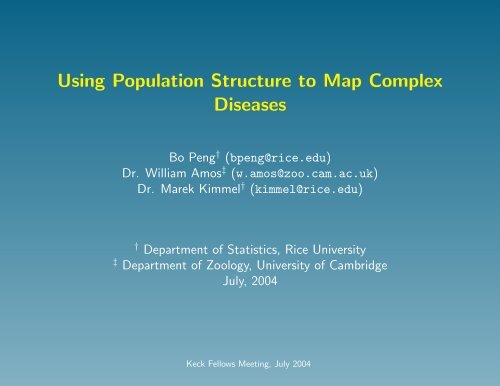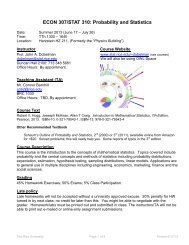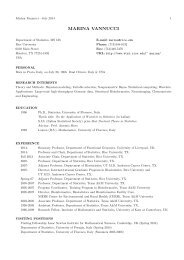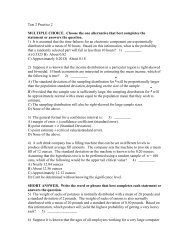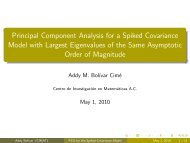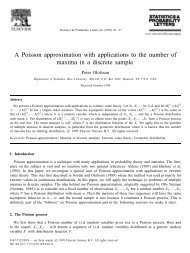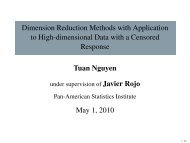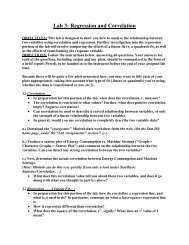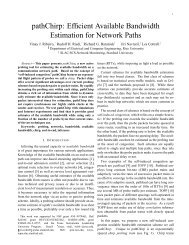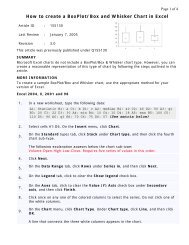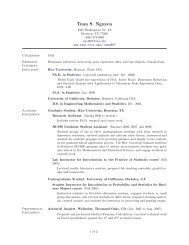slides in pdf format - Department of Statistics - Rice University
slides in pdf format - Department of Statistics - Rice University
slides in pdf format - Department of Statistics - Rice University
Create successful ePaper yourself
Turn your PDF publications into a flip-book with our unique Google optimized e-Paper software.
Us<strong>in</strong>g Population Structure to Map Complex<br />
Diseases<br />
Bo Peng † (bpeng@rice.edu)<br />
Dr. William Amos ‡ (w.amos@zoo.cam.ac.uk)<br />
Dr. Marek Kimmel † (kimmel@rice.edu)<br />
† <strong>Department</strong> <strong>of</strong> <strong>Statistics</strong>, <strong>Rice</strong> <strong>University</strong><br />
‡ <strong>Department</strong> <strong>of</strong> Zoology, <strong>University</strong> <strong>of</strong> Cambridge<br />
July, 2004<br />
Keck Fellows Meet<strong>in</strong>g, July 2004
Outl<strong>in</strong>e<br />
1. Background ideas<br />
• Genetic diseases and population structure<br />
• Problems <strong>of</strong> current approaches, and<br />
• How some new ideas might help
Outl<strong>in</strong>e<br />
1. Background ideas<br />
• Genetic diseases and population structure<br />
• Problems <strong>of</strong> current approaches, and<br />
• How some new ideas might help<br />
2. Some tech details<br />
• Basics <strong>of</strong> relatedness and <strong>in</strong>breed<strong>in</strong>g coefficient<br />
• How to estimate relatedness us<strong>in</strong>g genetic marker data
Outl<strong>in</strong>e<br />
1. Background ideas<br />
• Genetic diseases and population structure<br />
• Problems <strong>of</strong> current approaches, and<br />
• How some new ideas might help<br />
2. Some tech details<br />
• Basics <strong>of</strong> relatedness and <strong>in</strong>breed<strong>in</strong>g coefficient<br />
• How to estimate relatedness us<strong>in</strong>g genetic marker data<br />
3. An example<br />
Keck Fellows Meet<strong>in</strong>g, July 2004 1
Genetic diseases<br />
A genetic disease is a disease caused by abnormalities <strong>in</strong> an <strong>in</strong>dividuals’ genetic<br />
material (genome).<br />
A simple disease (e.g. cystic fibrosis) is caused by a defect <strong>in</strong> only one gene.<br />
By contract, complex diseases (e.g. most cancers) are caused by many variations<br />
occurred <strong>in</strong> different genes <strong>in</strong> the same cell. Different variations may lead to the<br />
same symptoms.
Genetic diseases<br />
A genetic disease is a disease caused by abnormalities <strong>in</strong> an <strong>in</strong>dividuals’ genetic<br />
material (genome).<br />
A simple disease (e.g. cystic fibrosis) is caused by a defect <strong>in</strong> only one gene.<br />
By contract, complex diseases (e.g. most cancers) are caused by many variations<br />
occurred <strong>in</strong> different genes <strong>in</strong> the same cell. Different variations may lead to the<br />
same symptoms.<br />
It is <strong>of</strong> vast <strong>in</strong>terest to f<strong>in</strong>d out which gene(s) are responsible for a genetic<br />
disease. This is <strong>in</strong> general called gene mapp<strong>in</strong>g. Many methods have been developed<br />
but the results have been disappo<strong>in</strong>t<strong>in</strong>g compared to the money <strong>in</strong>vested.<br />
• There are some success <strong>in</strong> mapp<strong>in</strong>g simple disease like cystic fibrosis, but not<br />
many.<br />
• Very few genes have been found for complex diseases.<br />
• Amont these genes, only a small fraction <strong>of</strong> them (∼ 5% ) can be consistently<br />
replicated by other researchers.
Genetic diseases<br />
A genetic disease is a disease caused by abnormalities <strong>in</strong> an <strong>in</strong>dividuals’ genetic<br />
material (genome).<br />
A simple disease (e.g. cystic fibrosis) is caused by a defect <strong>in</strong> only one gene.<br />
By contract, complex diseases (e.g. most cancers) are caused by many variations<br />
occurred <strong>in</strong> different genes <strong>in</strong> the same cell. Different variations may lead to the<br />
same symptoms.<br />
It is <strong>of</strong> vast <strong>in</strong>terest to f<strong>in</strong>d out which gene(s) are responsible for a genetic<br />
disease. This is <strong>in</strong> general called gene mapp<strong>in</strong>g. Many methods have been developed<br />
but the results have been disappo<strong>in</strong>t<strong>in</strong>g compared to the money <strong>in</strong>vested.<br />
• There are some success <strong>in</strong> mapp<strong>in</strong>g simple disease like cystic fibrosis, but not<br />
many.<br />
• Very few genes have been found for complex diseases.<br />
• Amont these genes, only a small fraction <strong>of</strong> them (∼ 5% ) can be consistently<br />
replicated by other researchers.<br />
Keck Fellows Meet<strong>in</strong>g, July 2004 2
Life <strong>of</strong> a disease gene – a hard one<br />
Genetic diseases are <strong>in</strong>troduced by mutation and spread through mat<strong>in</strong>g.
Life <strong>of</strong> a disease gene – a hard one<br />
Genetic diseases are <strong>in</strong>troduced by mutation and spread through mat<strong>in</strong>g.<br />
• Every allele is subject to a random sampl<strong>in</strong>g process if it is to survive to the next<br />
generation. The process is called genetic drift. Because the chance <strong>of</strong> survival<br />
<strong>of</strong> an allele is proportional to its frequency <strong>in</strong> population, most newborns (new<br />
mutations) get lost quickly because <strong>of</strong> genetic drift.
Life <strong>of</strong> a disease gene – a hard one<br />
Genetic diseases are <strong>in</strong>troduced by mutation and spread through mat<strong>in</strong>g.<br />
• Every allele is subject to a random sampl<strong>in</strong>g process if it is to survive to the next<br />
generation. The process is called genetic drift. Because the chance <strong>of</strong> survival<br />
<strong>of</strong> an allele is proportional to its frequency <strong>in</strong> population, most newborns (new<br />
mutations) get lost quickly because <strong>of</strong> genetic drift.<br />
• The hosts <strong>of</strong> disease alleles usually have smaller chance to produce <strong>of</strong>fspr<strong>in</strong>g<br />
(selective disadvantage). Many disease genes are thus elim<strong>in</strong>ated by selection.
Life <strong>of</strong> a disease gene – a hard one<br />
Genetic diseases are <strong>in</strong>troduced by mutation and spread through mat<strong>in</strong>g.<br />
• Every allele is subject to a random sampl<strong>in</strong>g process if it is to survive to the next<br />
generation. The process is called genetic drift. Because the chance <strong>of</strong> survival<br />
<strong>of</strong> an allele is proportional to its frequency <strong>in</strong> population, most newborns (new<br />
mutations) get lost quickly because <strong>of</strong> genetic drift.<br />
• The hosts <strong>of</strong> disease alleles usually have smaller chance to produce <strong>of</strong>fspr<strong>in</strong>g<br />
(selective disadvantage). Many disease genes are thus elim<strong>in</strong>ated by selection.<br />
• Mat<strong>in</strong>g is usually regional so travel<strong>in</strong>g (migration) is not easy, especially <strong>in</strong> the<br />
old days.<br />
Keck Fellows Meet<strong>in</strong>g, July 2004 3
Life <strong>of</strong> a disease gene – some good news<br />
• New alleles can be generated by recurrent mutation. However, this is usually<br />
not the case s<strong>in</strong>ce almost all mutations are unique. Instead, new mutations may<br />
lead to the same or slightly different phenotypes (disease).
Life <strong>of</strong> a disease gene – some good news<br />
• New alleles can be generated by recurrent mutation. However, this is usually<br />
not the case s<strong>in</strong>ce almost all mutations are unique. Instead, new mutations may<br />
lead to the same or slightly different phenotypes (disease).<br />
• There are late-onset diseases (such as Alzheimer’s disease) that do not affect<br />
reproduction. So selection is almost neutral <strong>in</strong> these cases.
Life <strong>of</strong> a disease gene – some good news<br />
• New alleles can be generated by recurrent mutation. However, this is usually<br />
not the case s<strong>in</strong>ce almost all mutations are unique. Instead, new mutations may<br />
lead to the same or slightly different phenotypes (disease).<br />
• There are late-onset diseases (such as Alzheimer’s disease) that do not affect<br />
reproduction. So selection is almost neutral <strong>in</strong> these cases.<br />
• Heterozygous disease allele carriers may have some selective advantages (heterozygous<br />
advantage) that helps the survival <strong>of</strong> disease allele.
Life <strong>of</strong> a disease gene – some good news<br />
• New alleles can be generated by recurrent mutation. However, this is usually<br />
not the case s<strong>in</strong>ce almost all mutations are unique. Instead, new mutations may<br />
lead to the same or slightly different phenotypes (disease).<br />
• There are late-onset diseases (such as Alzheimer’s disease) that do not affect<br />
reproduction. So selection is almost neutral <strong>in</strong> these cases.<br />
• Heterozygous disease allele carriers may have some selective advantages (heterozygous<br />
advantage) that helps the survival <strong>of</strong> disease allele.<br />
• A disease gene may get fixed (becomes the only allele at the locus) and live<br />
happily ever after. This happens much easier <strong>in</strong> small subpopulations with<br />
non-random mat<strong>in</strong>g.
Life <strong>of</strong> a disease gene – some good news<br />
• New alleles can be generated by recurrent mutation. However, this is usually<br />
not the case s<strong>in</strong>ce almost all mutations are unique. Instead, new mutations may<br />
lead to the same or slightly different phenotypes (disease).<br />
• There are late-onset diseases (such as Alzheimer’s disease) that do not affect<br />
reproduction. So selection is almost neutral <strong>in</strong> these cases.<br />
• Heterozygous disease allele carriers may have some selective advantages (heterozygous<br />
advantage) that helps the survival <strong>of</strong> disease allele.<br />
• A disease gene may get fixed (becomes the only allele at the locus) and live<br />
happily ever after. This happens much easier <strong>in</strong> small subpopulations with<br />
non-random mat<strong>in</strong>g.<br />
• Migration is gett<strong>in</strong>g easier!<br />
Keck Fellows Meet<strong>in</strong>g, July 2004 4
What do all these tell us<br />
• Disease gene tends to form clusters among spatially and/or genetically<br />
related <strong>in</strong>dividuals/families. Even among affected <strong>in</strong>dividuals/families, we<br />
may still expect cluster<strong>in</strong>g <strong>of</strong> disease alleles with<strong>in</strong> the population. ( Illustration:<br />
spatial distribution <strong>of</strong> alleles )
What do all these tell us<br />
• Disease gene tends to form clusters among spatially and/or genetically<br />
related <strong>in</strong>dividuals/families. Even among affected <strong>in</strong>dividuals/families, we<br />
may still expect cluster<strong>in</strong>g <strong>of</strong> disease alleles with<strong>in</strong> the population. ( Illustration:<br />
spatial distribution <strong>of</strong> alleles )<br />
• Many diseases are recessive. Disease alleles are more likely to be expressed<br />
<strong>in</strong> <strong>in</strong>dividuals born to related parents, and <strong>in</strong> particular to parents who are<br />
closely related for the section <strong>of</strong> their genome <strong>in</strong> which a susceptibility factor<br />
lies. Consequently, the presence <strong>of</strong> recessive factors can be <strong>in</strong>ferred wherever<br />
affected <strong>in</strong>dividuals exhibit unusually elevated levels <strong>of</strong> relatedness<br />
between homologous chromosomes at some place <strong>in</strong> their genome. (<br />
Illustration: homologous chromosomes )<br />
Keck Fellows Meet<strong>in</strong>g, July 2004 5
Basic gene mapp<strong>in</strong>g methods<br />
Genes that are close to a disease gene tend to co-segregate with it dur<strong>in</strong>g<br />
meiosis. Therefore, if a gene is over/under-present <strong>in</strong> the diseased population than<br />
<strong>in</strong> the general population, this gene might be close to one <strong>of</strong> the disease genes.
Basic gene mapp<strong>in</strong>g methods<br />
Genes that are close to a disease gene tend to co-segregate with it dur<strong>in</strong>g<br />
meiosis. Therefore, if a gene is over/under-present <strong>in</strong> the diseased population than<br />
<strong>in</strong> the general population, this gene might be close to one <strong>of</strong> the disease genes.<br />
This leads to case-control studies:<br />
• Collect two groups <strong>of</strong> people, one with disease (case group) and one without<br />
(control group).<br />
• F<strong>in</strong>d out the genotypic <strong>in</strong><strong>format</strong>ion <strong>of</strong> as many markers as fund<strong>in</strong>g allows, and<br />
compare the allele frequencies <strong>of</strong> case and control groups.<br />
If the population is genetically homogeneous and the marker is not l<strong>in</strong>ked to a<br />
susceptibility factor (disease locus), these allele frequencies should roughly be the<br />
same. Any significant difference <strong>in</strong> allele frequency can then be used to <strong>in</strong>fer an<br />
association (l<strong>in</strong>kage) between the marker and a disease locus.<br />
Keck Fellows Meet<strong>in</strong>g, July 2004 6
What trouble can population structure make<br />
The homogeneity assumption does not hold <strong>in</strong> the presence <strong>of</strong> population<br />
structure, when both disease frequency and marker allele frequencies can differ<br />
among subpopulations.
What trouble can population structure make<br />
The homogeneity assumption does not hold <strong>in</strong> the presence <strong>of</strong> population<br />
structure, when both disease frequency and marker allele frequencies can differ<br />
among subpopulations.<br />
For example: suppose a sample <strong>of</strong> cases and controls is drawn from a population<br />
conta<strong>in</strong><strong>in</strong>g a number <strong>of</strong> subpopulations. If the disease <strong>of</strong> <strong>in</strong>terest is at high frequency<br />
<strong>in</strong> one subpopulation, then we can expect to f<strong>in</strong>d that group overrepresented among<br />
the cases. Then, any marker allele that is at higher frequency <strong>in</strong> that subpopulation<br />
than <strong>in</strong> the others will appear to be associated with the disease, regardless <strong>of</strong> where<br />
it is <strong>in</strong> the genome. In other words, a spurious association will be found.<br />
Keck Fellows Meet<strong>in</strong>g, July 2004 7
In the case <strong>of</strong> complex disease<br />
Population structure is more important when mapp<strong>in</strong>g complex diseases because<br />
• Disease susceptibility factors are likely to contribute to some families but not to<br />
others;<br />
• Disease gene tends to form clusters among spatially and/or genetically related<br />
<strong>in</strong>dividuals/families.<br />
If we treat families as <strong>in</strong>dependent observations, families for whom the factor is not<br />
important or present will contribute background noise that may mask the signal<br />
from those families where it does play a role.<br />
Keck Fellows Meet<strong>in</strong>g, July 2004 8
Current Fixes to Population Structure<br />
Population admixture has been widely recognized as the major reason for<br />
nonreplicability associations [Ardie et al 2002 ]. To overcome this problem, people either<br />
avoid population based case control studies ( use TDT tests <strong>in</strong>stead ) or<br />
• use markers throughout the genome to adjust for any <strong>in</strong>flation <strong>in</strong> test statistics<br />
due to substructure ( Genomic control [Bacanu et al 2000, Devl<strong>in</strong> et al 2001] )<br />
• <strong>in</strong>fer the details <strong>of</strong> the subpopulations ( Structured Association [ Pritchard et al 2000,<br />
Thornsberry et al 2001 ], etc)<br />
However, there are no clear-cut subpopulations <strong>in</strong> a sample <strong>in</strong> many cases. Even<br />
there are, it is very difficult to estimate the number <strong>of</strong> subpopulations and classify<br />
samples <strong>in</strong>to them. Homogeneity with<strong>in</strong> subpopulations is also hard to prove.<br />
Keck Fellows Meet<strong>in</strong>g, July 2004 9
Us<strong>in</strong>g Population Structure to Map Complex Diseases<br />
We have developed an algorithm to map complex diseases. We do not explicitly<br />
identify subpopulations. Instead, we construct a neighborhood <strong>of</strong> families for each<br />
family by putt<strong>in</strong>g weights on families accord<strong>in</strong>g to family relatedness measures.
Us<strong>in</strong>g Population Structure to Map Complex Diseases<br />
We have developed an algorithm to map complex diseases. We do not explicitly<br />
identify subpopulations. Instead, we construct a neighborhood <strong>of</strong> families for each<br />
family by putt<strong>in</strong>g weights on families accord<strong>in</strong>g to family relatedness measures.<br />
• Estimate family relatedness us<strong>in</strong>g marker data. The family relatedness<br />
measures are the averaged relatedness coef between all <strong>in</strong>ter-family <strong>of</strong>fspr<strong>in</strong>g<br />
comb<strong>in</strong>ations, which can be estimated by, for example, Queller’s Method [ Queller<br />
1989, Lynch et al 1999 ]<br />
ˆr xy =<br />
1<br />
2 (δ ac + δ ad + δ bc + δ bd ) − p a − p b<br />
1 + δ ab − p a − p b<br />
where (a, b), (c, d) are genotypes <strong>of</strong> <strong>in</strong>dividual x and y. p a is the population<br />
frequency <strong>of</strong> allele a.<br />
• Def<strong>in</strong>e a weight<strong>in</strong>g system that falls <strong>of</strong>f with <strong>in</strong>creas<strong>in</strong>g distance away along<br />
the chromosome and also with decreas<strong>in</strong>g relatedness across families.<br />
Keck Fellows Meet<strong>in</strong>g, July 2004 10
Our Approach (cont.)<br />
• Measure the <strong>in</strong>breed<strong>in</strong>g level <strong>of</strong> each locus for each family. The locus-level<br />
<strong>in</strong>breed<strong>in</strong>g measures are estimated by, for example, Internal Relatedness<br />
ˆr x = 2δ ab − p a − p b<br />
2 − p a − p b<br />
• Average the <strong>in</strong>breed<strong>in</strong>g measures us<strong>in</strong>g the<br />
weight<strong>in</strong>g system. We <strong>in</strong>fer the presence <strong>of</strong><br />
recessive factors wherever affected <strong>in</strong>dividuals exhibit<br />
unusually elevated levels <strong>of</strong> relatedness between<br />
homologous chromosomes at some place <strong>in</strong><br />
their genome.<br />
• The significance <strong>of</strong> high average measures can be tested by randomiz<strong>in</strong>g<br />
the relatedness values and the marker locations and ask<strong>in</strong>g the extent to which<br />
the observed sum is large relative to randomized measures.<br />
Keck Fellows Meet<strong>in</strong>g, July 2004 11
Tech details: Inbreed<strong>in</strong>g Coefficient<br />
Inbreed<strong>in</strong>g means mat<strong>in</strong>g between closely related <strong>in</strong>dividuals. (Illustration:<br />
<strong>in</strong>breed<strong>in</strong>g) Inbreed<strong>in</strong>g Coefficient is the probability that random alleles <strong>in</strong> different<br />
<strong>in</strong>dividuals/groups have descended from a s<strong>in</strong>gle ancestral allele (this is called ibd:<br />
Identical by descent)
Tech details: Inbreed<strong>in</strong>g Coefficient<br />
Inbreed<strong>in</strong>g means mat<strong>in</strong>g between closely related <strong>in</strong>dividuals. (Illustration:<br />
<strong>in</strong>breed<strong>in</strong>g) Inbreed<strong>in</strong>g Coefficient is the probability that random alleles <strong>in</strong> different<br />
<strong>in</strong>dividuals/groups have descended from a s<strong>in</strong>gle ancestral allele (this is called ibd:<br />
Identical by descent) Note that<br />
• Relatedness between two <strong>in</strong>dividuals/groups with multiple loci are the average<br />
<strong>of</strong> locus level relatedness measures.
Tech details: Inbreed<strong>in</strong>g Coefficient<br />
Inbreed<strong>in</strong>g means mat<strong>in</strong>g between closely related <strong>in</strong>dividuals. (Illustration:<br />
<strong>in</strong>breed<strong>in</strong>g) Inbreed<strong>in</strong>g Coefficient is the probability that random alleles <strong>in</strong> different<br />
<strong>in</strong>dividuals/groups have descended from a s<strong>in</strong>gle ancestral allele (this is called ibd:<br />
Identical by descent) Note that<br />
• Relatedness between two <strong>in</strong>dividuals/groups with multiple loci are the average<br />
<strong>of</strong> locus level relatedness measures.<br />
• This concept can be generalized to <strong>in</strong>breed<strong>in</strong>g <strong>of</strong> one <strong>in</strong>dividual or one population.<br />
In these cases, ‘random alleles’ are picked from an <strong>in</strong>dividual (with two alleles)<br />
or a group <strong>of</strong> <strong>in</strong>dividuals (random alleles from random <strong>in</strong>dividuals with<strong>in</strong> this<br />
group).
Tech details: Inbreed<strong>in</strong>g Coefficient<br />
Inbreed<strong>in</strong>g means mat<strong>in</strong>g between closely related <strong>in</strong>dividuals. (Illustration:<br />
<strong>in</strong>breed<strong>in</strong>g) Inbreed<strong>in</strong>g Coefficient is the probability that random alleles <strong>in</strong> different<br />
<strong>in</strong>dividuals/groups have descended from a s<strong>in</strong>gle ancestral allele (this is called ibd:<br />
Identical by descent) Note that<br />
• Relatedness between two <strong>in</strong>dividuals/groups with multiple loci are the average<br />
<strong>of</strong> locus level relatedness measures.<br />
• This concept can be generalized to <strong>in</strong>breed<strong>in</strong>g <strong>of</strong> one <strong>in</strong>dividual or one population.<br />
In these cases, ‘random alleles’ are picked from an <strong>in</strong>dividual (with two alleles)<br />
or a group <strong>of</strong> <strong>in</strong>dividuals (random alleles from random <strong>in</strong>dividuals with<strong>in</strong> this<br />
group).<br />
• Inbreed<strong>in</strong>g coefficient has other names such as coefficient <strong>of</strong> coancestry, Consangu<strong>in</strong>ity<br />
coefficient, K<strong>in</strong>ship. They commonly refer to <strong>in</strong>breed<strong>in</strong>g between two<br />
<strong>in</strong>dividuals.<br />
Keck Fellows Meet<strong>in</strong>g, July 2004 12
Population Explanation <strong>of</strong> Inbreed<strong>in</strong>g Coefficient<br />
Suppose that p and q are frequency <strong>of</strong> two alleles at a locus. Under HWE, the<br />
frequency <strong>of</strong> heterozygous genotype should be 2pq, we call this frequency <strong>in</strong> general<br />
H 0 . In case <strong>of</strong> breed<strong>in</strong>g, this frequency is H 1 and <strong>in</strong>breed<strong>in</strong>g coefficient (for this<br />
population)F is def<strong>in</strong>ed as<br />
F = H 0 − H 1<br />
H 0<br />
One can deduce formulae <strong>of</strong> genotype frequencies <strong>in</strong> a population with <strong>in</strong>breed<strong>in</strong>g<br />
level F . We can see that <strong>in</strong>breed<strong>in</strong>g causes a decrease <strong>of</strong> heterozygosity.<br />
genotype frequency wih <strong>in</strong>breed<strong>in</strong>g under Hardy-We<strong>in</strong>berg Equilibrium<br />
AA p 2 + pqF p 2<br />
Aa 2pq (1 − F ) 2pq<br />
aa q 2 + pqF q 2<br />
Keck Fellows Meet<strong>in</strong>g, July 2004 13
Estimate Inbreed<strong>in</strong>g Coef. from Pedigree Data<br />
Wright’s (1922) formula:<br />
F I = ∑ i<br />
( 1<br />
2<br />
) ni<br />
(1 + F Ai )<br />
where i is the ith common ancestor, n i is<br />
the number <strong>of</strong> <strong>in</strong>dividuals <strong>in</strong>side the loop<br />
I → A i → I.
Estimate Inbreed<strong>in</strong>g Coef. from Pedigree Data<br />
Wright’s (1922) formula:<br />
F I = ∑ i<br />
( 1<br />
2<br />
) ni<br />
(1 + F Ai )<br />
where i is the ith common ancestor, n i is<br />
the number <strong>of</strong> <strong>in</strong>dividuals <strong>in</strong>side the loop<br />
I → A i → I.<br />
For the left pedigree, n G = 2,<br />
F I =<br />
( 1<br />
2<br />
) 2<br />
(1 + F G ) = 1 4<br />
Keck Fellows Meet<strong>in</strong>g, July 2004 14
Family Level Relatedness: Dr. Queller’s Method<br />
Pedigree data is usually unavailable between families. (Need huge pedigrees)<br />
Fortunately, progress <strong>in</strong> the develop<strong>in</strong>g <strong>of</strong> methods <strong>of</strong> estimat<strong>in</strong>g parental relatedness<br />
from marker data has been rapid. Suppose that <strong>in</strong>dividuals x has genotype (a, b)<br />
and <strong>in</strong>dividual y has genotype . Suppose that the allele frequencies <strong>of</strong> these alleles<br />
are p a , p b , p c , p d . The (directional) relatedness between x and y is given by<br />
ˆr xy =<br />
1<br />
2 (δ ac + δ ad + δ bc + δ bd ) − p a − p b<br />
1 + δ ab − p a − p b<br />
where δ ac = 1 if a = c and 0 otherwise. Usually, directional measures are averaged<br />
to get a better estimate, the formula becomes<br />
ˆr xy = δ ac + δ ad + δ bc + δ bd − p a − p b − p c − p d<br />
2 + δ ab + δ cd − p a − p b − p c − p dd<br />
Keck Fellows Meet<strong>in</strong>g, July 2004 15
Dr. Queller’s Method (Cont. 1)<br />
• When multiple markers are available, the relatedness measure is the average <strong>of</strong><br />
locus-level measures.
Dr. Queller’s Method (Cont. 1)<br />
• When multiple markers are available, the relatedness measure is the average <strong>of</strong><br />
locus-level measures.<br />
• Relatedness measures between two groups is the average <strong>of</strong> relatedness coef<br />
between all <strong>in</strong>ter-family <strong>of</strong>fspr<strong>in</strong>g comb<strong>in</strong>ations.
Dr. Queller’s Method (Cont. 1)<br />
• When multiple markers are available, the relatedness measure is the average <strong>of</strong><br />
locus-level measures.<br />
• Relatedness measures between two groups is the average <strong>of</strong> relatedness coef<br />
between all <strong>in</strong>ter-family <strong>of</strong>fspr<strong>in</strong>g comb<strong>in</strong>ations.<br />
• Simulation results <strong>in</strong>dicate that a+b<br />
c+d averag<strong>in</strong>g performs better than 1 2<br />
( a<br />
c + b d)<br />
.<br />
It is therefore preferable to keep track <strong>of</strong> numerator/denom<strong>in</strong>ator at all time<br />
dur<strong>in</strong>g calculation.
Dr. Queller’s Method (Cont. 1)<br />
• When multiple markers are available, the relatedness measure is the average <strong>of</strong><br />
locus-level measures.<br />
• Relatedness measures between two groups is the average <strong>of</strong> relatedness coef<br />
between all <strong>in</strong>ter-family <strong>of</strong>fspr<strong>in</strong>g comb<strong>in</strong>ations.<br />
• Simulation results <strong>in</strong>dicate that a+b<br />
c+d averag<strong>in</strong>g performs better than 1 2<br />
( a<br />
c + b d)<br />
.<br />
It is therefore preferable to keep track <strong>of</strong> numerator/denom<strong>in</strong>ator at all time<br />
dur<strong>in</strong>g calculation.<br />
• Other methods are also available, notable from Lynch 1999.<br />
Keck Fellows Meet<strong>in</strong>g, July 2004 16
Locus Level Relatedness Measures<br />
The follow<strong>in</strong>g measures have been proposed:<br />
• Heterozygosity (Het)<br />
Straight heterozygosity does uncover strong effects <strong>in</strong> natural populations <strong>of</strong><br />
animals and plants, but rema<strong>in</strong>s a somewhat crude measure.
Locus Level Relatedness Measures<br />
The follow<strong>in</strong>g measures have been proposed:<br />
• Heterozygosity (Het)<br />
Straight heterozygosity does uncover strong effects <strong>in</strong> natural populations <strong>of</strong><br />
animals and plants, but rema<strong>in</strong>s a somewhat crude measure.<br />
• d-squared (d 2 )<br />
Microsatellite alleles diverge <strong>in</strong> a way such that the square <strong>of</strong> the length difference<br />
between a pair <strong>of</strong> alleles may be l<strong>in</strong>early related to time s<strong>in</strong>ce their common<br />
ancestor. Consequently, the average squared allele length difference across either<br />
loci or <strong>in</strong>dividuals provides an estimator for overall genomic similarity. Let<br />
Mx (h) be the number <strong>of</strong> alleles at locus h, denote the genotype <strong>of</strong> <strong>in</strong>dividual<br />
i as (a ih , b ih ),<br />
d 2 = mean<br />
( ) 2<br />
aih − b ih<br />
Mx (h) − 2<br />
Keck Fellows Meet<strong>in</strong>g, July 2004 17
Locus Level Relatedness Measure (Cont.)<br />
• Standardized heterozygosity (SH) and Standardized Observed Heterozygosity<br />
(SOH)<br />
SH is heterozygosity but weighted by the expected heterozygosity at each locus<br />
scored. SOH is a version <strong>of</strong> SH where the correction is made us<strong>in</strong>g observed<br />
heterozygosity, rather than expected heterozygosity. This is a more robust<br />
method <strong>in</strong> comparison with others.
Locus Level Relatedness Measure (Cont.)<br />
• Standardized heterozygosity (SH) and Standardized Observed Heterozygosity<br />
(SOH)<br />
SH is heterozygosity but weighted by the expected heterozygosity at each locus<br />
scored. SOH is a version <strong>of</strong> SH where the correction is made us<strong>in</strong>g observed<br />
heterozygosity, rather than expected heterozygosity. This is a more robust<br />
method <strong>in</strong> comparison with others.<br />
• Internal Relatedness<br />
Internal relatedness was developed by William Amos <strong>in</strong> Cambridge and quantifies<br />
the degree <strong>of</strong> heterozygosity weighted by the frequencies <strong>of</strong> the alleles <strong>in</strong> each<br />
genotype. Us<strong>in</strong>g the similar notation as that <strong>of</strong> d 2 measure<br />
IR =<br />
∑ ∑<br />
i<br />
h<br />
∑<br />
i<br />
(<br />
2δaih =b ih<br />
− f aih − f bih<br />
)<br />
∑ ( )<br />
h 2 − faih − f bih<br />
Keck Fellows Meet<strong>in</strong>g, July 2004 18
Log P-values <strong>of</strong> Locus Association<br />
Leprosy dataset<br />
[Siddiqui et al 2001]<br />
394 <strong>in</strong>dividuals<br />
96 nuclear<br />
families<br />
all <strong>of</strong>fspr<strong>in</strong>gs are<br />
affected<br />
295 microsatellite<br />
markers on 22<br />
autosomes are<br />
typed<br />
0 1 2 3 4 5<br />
25<br />
D10S591<br />
7<br />
D10S189<br />
18<br />
D10S547<br />
9<br />
D10S191<br />
1<br />
D10S1653<br />
5<br />
D10S1763<br />
3<br />
D10S1661<br />
19<br />
D10S548<br />
4<br />
D10S1662<br />
Overall Measures on Chromosome 10<br />
22<br />
D10S582<br />
23<br />
D10S586<br />
20<br />
D10S563<br />
2<br />
D10S1660<br />
loci<br />
21<br />
D10S572<br />
11<br />
D10S197<br />
13<br />
D10S208<br />
16<br />
D10S220<br />
0<br />
D10S1652<br />
17<br />
D10S537<br />
12<br />
D10S201<br />
6<br />
D10S185<br />
10<br />
D10S192<br />
8<br />
D10S190<br />
24<br />
D10S587<br />
15<br />
−log(P−value)<br />
scaled IBD MLS<br />
AfIR<br />
UnIR<br />
AfRel<br />
D10S217<br />
14<br />
D10S212<br />
Our result confirms the reported susceptibility locus on chromosome 10, as well<br />
as most <strong>of</strong> the less-significant ones.<br />
Keck Fellows Meet<strong>in</strong>g, July 2004 19
• What I have done<br />
Summary and Future Work<br />
⋆ Implement a fast (relative to the extensive computation needed) and flexible<br />
algorithm that can perform our method us<strong>in</strong>g various family level and locus<br />
level relatedness measures, and various randomization methods;<br />
⋆ Test our algorithm on six real datasets; Test the robustness <strong>of</strong> our algorithm<br />
us<strong>in</strong>g partial <strong>in</strong><strong>format</strong>ion <strong>of</strong> the datasets;<br />
⋆ Compare the performance <strong>of</strong> two family-level relatedness measures;<br />
⋆ Present a poster at the 9th Structural Biology Symposium.
• What I have done<br />
Summary and Future Work<br />
⋆ Implement a fast (relative to the extensive computation needed) and flexible<br />
algorithm that can perform our method us<strong>in</strong>g various family level and locus<br />
level relatedness measures, and various randomization methods;<br />
⋆ Test our algorithm on six real datasets; Test the robustness <strong>of</strong> our algorithm<br />
us<strong>in</strong>g partial <strong>in</strong><strong>format</strong>ion <strong>of</strong> the datasets;<br />
⋆ Compare the performance <strong>of</strong> two family-level relatedness measures;<br />
⋆ Present a poster at the 9th Structural Biology Symposium.<br />
• Future Work ... lots <strong>of</strong> it<br />
⋆ This work is purely empirical right now. Statistical <strong>in</strong>ference is not yet<br />
possible.<br />
⋆ Simulate related/unrelated family data and test the strength/variability <strong>of</strong> our<br />
method. Simulation program EASYPOP [ Balloux 2001] is used.<br />
⋆ Evaluate some new relatedness measures (both family level and locus level).<br />
⋆ Adapt our method to SNP markers for f<strong>in</strong>e mapp<strong>in</strong>g purpose.<br />
Keck Fellows Meet<strong>in</strong>g, July 2004 20
References<br />
[1] Balloux F. Easypop, a computer program for the simulation <strong>of</strong> population<br />
genetics. J. Heredity, pages 301–302, 92.<br />
[2] Michael Lynch and Kermit Ritland. Estimation <strong>of</strong> pairwise relatedness with<br />
molecular markers. Genetics, (152):1753–1766, Aug 1999.<br />
[3] David C. Queller and Keith F. Goodnight. Estimat<strong>in</strong>g relatedness us<strong>in</strong>g genetic<br />
markers. Evolution, 43(2):258–275, Mar 1989.<br />
[4] M. Ruby Siddiqui, Sarah Meisner, Kerrie Tosh, Karuppiah Balakrishnan, Satish<br />
Ghei, S<strong>in</strong>on E. Fisher, Mar<strong>in</strong>a Gold<strong>in</strong>g, Nallakandy P Shanker Narayan, Thiagarajan<br />
Sitarman, Utpal Sengupta, Ramasamy Pitchappan, and Adrian V.S.<br />
Hill. A major susceptibility locus for leprosy <strong>in</strong> <strong>in</strong>dia maps to chromosome<br />
10p13. Natural Genetics, 27:439–441, April 2001.<br />
go back to front, ideas, tech details, example<br />
Keck Fellows Meet<strong>in</strong>g, July 2004 21


